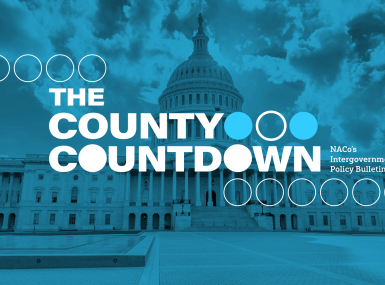Legislative Analysis: What New NEPA Guidelines Mean for Counties

Author

Charlotte Mitchell Duyshart
Upcoming Events
Related News
The National Environmental Policy Review Act (NEPA) established the national environmental review process and established the Council on Environmental Quality (CEQ) within the Executive Office of the President to advise the president and review federal programs’ environmental impacts. Enacted in 1970, NEPA requires federal agencies to conduct environmental reviews on federally funded projects that could impact the environment.
Jump to Section
The National Environmental Policy Review Act (NEPA) established the national environmental review process and established the Council on Environmental Quality (CEQ) within the Executive Office of the President to advise the president and review federal programs’ environmental impacts. Enacted in 1970, NEPA requires federal agencies to conduct environmental reviews on federally funded projects that could impact the environment.
Recent Federal Actions Regarding NEPA
On January 20, President Trump signed Executive Order 14154 – Unleashing American Energy that directed the leaders of multiple federal agencies such as the U.S. Departments of Agriculture (USDA), Commerce (DOC), Defense (DOD), Energy (DOE), Homeland Security (DHS), Housing and Urban Development (HUD), Interior (DOI) and Transportation (DOT) as well as the Environmental Protection Agency (EPA), Council on Environmental Quality (CEQ), and other relevant agencies to work to eliminate all delays within their respective permitting processes.
In response to the Unleashing American Energy EO, CEQ issued a rulemaking removing their authority to create new regulations under NEPA and to remove current CEQ NEPA regulations from the federal code on February 25. CEQ also issued a memo directing federal agencies to “revise or establish their NEPA implementing procedures (or establish such procedures if they do not yet have any) to expedite permitting approvals and for consistency with NEPA as amended by the Fiscal Responsibility Act (FRA), including the deadlines established in NEPA.”
On July 3, several agencies released updated NEPA procedures in accordance with the CEQ memo. USDA, DOE, DOI, DOT and the Army Corps of Engineers published interim final rules while the Federal Energy Regulatory Commission (FERC) published a final rule. NACo submitted comments to the five agencies accepting comments on their interim final rule. The comment letter can be found here.
Updated NEPA Guidelines By Agency
See below summaries of each agency’s updated NEPA guidance. NACo will update this analysis as more agencies release updated guidance.
NEPA Applicability:
- NEPA is procedural only, not a source of regulatory authority.
- NEPA does not apply when:
- There is no final agency action
- A legal exemption exists
- Another law overrides NEPA
- Congress has removed agency discretion on environmental issues
- Another statute fulfills NEPA’s purpose
- The activity is not a “major Federal action”
- Example: Jurisdictional determinations (e.g., if an area falls under Corps jurisdiction) are not subject to NEPA
Categorical Exclusions (CEs):
- The Corps will:
- Use existing CEs
- Adopt CEs from other agencies if appropriate
- Consider creating or revising CEs
- If no CE applies, the Corps determines the necessary level of environmental review
Environmental Assessments (EAs) & Environmental Impact Statements (EISs):
- EAs:
- Must be completed within 1 year
- Limited to 75 pages
- EISs:
- Must be completed within 2 years
- Limited to 150 pages
- Must include input from state, tribal, and local agencies
- Wherever possible, the Corps will adopt or rely on existing EAs/EISs and other environmental documents
Role of Cooperating Agencies:
- The Corps’ guidance addresses its role only as a cooperating or lead Federal agency
- State, local, and tribal governments are not explicitly included as cooperating agencies, though their participation is considered important
- As a lead agency, the Corps:
- Manages the NEPA process
- Determines the scope of analysis
- As a cooperating agency, the Corps:
- Provides relevant environmental information to the lead agency
Scope and Cooperation:
- NEPA reviews must include impacts on all Federal interests
- The Corps is directed to:
- Use environmental reviews from other agencies whenever practical
- Reduce duplication by cooperating with State, Tribal, and local agencies
- Incorporate by reference relevant studies, analyses, and decisions
Consolidated NEPA Procedures Across USDA:
- All agency-specific NEPA regulations are rescinded and replaced with a single, department-wide NEPA regulation
- Agencies must first determine whether a proposed action is a “major federal action” subject to NEPA
- Emphasis on using the least complex level of review, such as categorical exclusions (CEs), when possible
Categorical Exclusions (CEs):
- A master list of CEs is now available for use across all USDA agencies.
- Any agency can adopt and apply any CE on this list
- New guidance provided for identifying “extraordinary circumstances” (e.g., presence of endangered species), where even CE-eligible actions may require more review
Environmental Assessments (EAs) and Environmental Impact Statements (EISs):
- Enforces page and time limits from the FRA
- Encourages use of prior analyses for similar actions
- Expands role of applicants and third parties in preparing NEPA documentation, including CEs
- EAs
- EAs are defined as concise documents supporting a Finding of No Significant Impact (FONSI)
- USDA agencies encouraged to document changes based on stakeholder input
- All EAs and FONSIs will be published online for public transparency
- EISs
- Eliminates requirements for summary, index, and list of preparers
- Draft EISs are optional; scoping is not required
- Removes 30-day waiting period between final EIS and Record of Decision (ROD)
- Agencies can now move to decision-making immediately after the final EIS
Categorial Exclusions (CEs):
- This rule removed large portions of prior NEPA guidance and shifts the focus to utilizing CEs as much as possible.
- The IFR encourages DOE to start reviews by looking for existing CEs and to develop new CEs if no existing CEs are relevant to applications
Local Consultation:
- There is no requirement for DOE to work with cooperating agencies such as counties when conducting NEPA reviews
- NEPA procedures will now exist in non-binding sub-regulatory guidance that is not codified in regulations
- DOE is given the discretion to change NEPA procedures without public input through a notice and comment period
Emergency Responses:
- DOI retains authority to take urgent action without prior NEPA review
- Requires consideration and mitigation of environmental impacts where possible
- Alternative arrangements allowed for actions beyond immediate emergency needs
Categorical Exclusions (CEs):
- Regulations governing CEs are retained but updated:
- Agencies can use CEs from other agencies or multiple CEs for one action.
- Hazardous fuels reduction and post-fire rehabilitation removed from Departmental CEs (now handled at the bureau level).
- “Extraordinary circumstances” narrowed:
- Eliminates references to controversial effects, potential legal violations, environmental justice, and executive orders
DOI NEPA Handbook
- DOI moved most of its NEPA guidance into a nonbinding handbook that can be revised without a notice and comment period
NEPA Review Levels:
- Criteria for choosing CE, EA, or EIS retained
- Greater discretion given to Responsible Officials
- Reviews focus only on adverse effects, excluding distant or unrelated impacts
Categorical Exclusions (CEs):
- Operational procedures now only in the Handbook
- Reflects regulatory changes: easier adoption, use across agencies, narrowed exceptions
Environmental Assessments (EAs):
- 75-page limit, 1-year deadline (with limited extensions)
- Focus only on significant impacts
- Encourages use of existing data over new research unless necessary
Environmental Impact Statements (EISs):
- 150-page limit (300 for complex actions), 2-year deadline
- Streamlined public comment process
- Proportionate analysis only on significant effects
Public Engagement:
- Scoping and notices of intent are still required
- More flexibility in timing/methods of public involvement
Local Consultation:
- Emphasis on early coordination with state, tribal, and local governments
- Encourages joint planning and formal agreements
Cooperating Agency Provisions Removed from Regulation:
- Removed from CFR, now appear only in the Handbook
- No longer legally enforceable — guidance only
- Greater discretion for DOI officials in inviting/coordinating with other agencies
- Reduces legal durability and procedural guarantees previously provided by regulation
In addition to the IFRs issued for the Federal Highway Administration (FHWA), Federal Transit Administration (FTA) and Federal Railroad Administration (FRA), USDOT issued a department-wide order instructing all DOT agencies to:
- Be proactive in using existing CEs
- Clarify what constitutes a “major Federal action”
- Reduce paperwork and consolidate documents
- Cooperate with State, Tribal, and local agencies to avoid duplicative reviews, including by using local studies and decisions
Interim Final Rule for FHWA, FTA, and FRA
Categorical Exclusions (CEs):
- Agencies can now:
- Adopt CEs from other federal agencies more easily
- Rely on another agency’s CE decision for similar actions
- Reflects statutory changes from the Fiscal Responsibility Act
Environmental Assessments (EAs):
- EAs are:
- Limited to 75 pages
- Must be completed within 1 year
- Must be made public and shared with impacted local officials, though public comment is not required
Environmental Impact Statements (EISs):
- Page limits:
- 150–200 pages for most projects
- Up to 300 pages for complex projects
- Must be completed within 2 years.
- Draft EISs are still required, but:
- Drafting is simplified
- Only a “reasonable range of alternatives” needs to be considered
- Draft EISs must be circulated with public officials and other agencies
Local Consultation:
- Confirms compliance with Executive Order 13132 - Federalism
- Encourages coordination with State, Tribal, and local agencies
Federal Aviation Administration (FAA) Guidance
Categorical Exclusions (CEs):
- FAA may adopt CEs from other USDOT and federal agencies
- However, the process is more complex than for other modal administrations
Environmental Assessments (EAs):
- Same as other agencies: 75-page limit, 1-year deadline
- Lists specific actions requiring EAs, such as:
- New or relocated Airport Traffic Control Towers
- Relocated Approach Lighting Systems (ALS)
Environmental Impact Statements (EISs):
- Required for major projects, such as:
- New commercial airports
- Major runway extensions
- EISs are limited to 150–200 pages, or 300 for complex projects
Local Consultation:
- FAA must collect comments from agencies with environmental regulatory authority
- Not required to seek comments from state, Tribal, or local governments that are merely affected
- Encourages coordination to reduce duplication using local analyses and decisions
Categorical Exclusions (CEs):
- FERC can:
- Use its own existing CEs
- Adopt CEs from other agencies
- Recommend or develop new CEs
- Before using a CE, staff must:
- Assess for “extraordinary circumstances” that could trigger further review
- Consult with the approving agency
- Publish public notice in the Federal Register
Environmental Assessments (EAs):
- Must:
- Be completed within 1 year
- Be limited to 75 pages
- Analyze purpose, need, alternatives, and environmental impacts
- Include certification of compliance with statutory mandates
- Be published online with supporting findings
Environmental Impact Statements (EISs):
- Required for projects with significant environmental impact
- Page limits:
- 150 pages standard
- 300 pages for complex projects
- Must be completed within 2 years
- Indexes and summaries are no longer required
- Final EISs must be published online with a Record of Decision (ROD)
Local and Tribal Coordination:
- Encourages early cooperation with State, Tribal, and local agencies
- Supports reducing duplication by using existing studies, analyses, and decisions from those entities
New Staff Guidance Manual:
- Becomes the primary framework for NEPA compliance at FERC
- Guides staff on:
- Determining whether NEPA review is required and the appropriate level of analysis
- Including environmental information early in the decision-making process
- Conducting efficient, timely, and coordinated reviews
- Implementing NEPA rules for roles, timelines, and applicant-prepared documents
Impacts of New NEPA Guidelines for Counties
The updated NEPA guidelines present several challenges for counties. CEQ provided NEPA guidance that was standard across the federal government. However, the recent rescission of the CEQ guidance has created a patchwork NEPA system that could lead to delays for projects that must potentially clear multiple sets of guidance across multiple agencies.
The role of counties as cooperating agencies is also unclear in this new patchwork NEPA system. Counties support streamlining the NEPA process to better serve residents through the construction of critical infrastructure such as roads, bridges, highways, ports, irrigation systems, forest management, transmission lines, energy projects, broadband and water infrastructure. However, not all the agencies included in this analysis outline how counties and other local government stakeholders will be included during the early stages of the planning process. This lack of coordination prevents counties and other local governments from aligning local requirements — such as zoning modifications — with federal permitting actions, adding unnecessary time to project completion.
NACo will continue engaging with federal agencies and Congress to ensure counties have a seat at the table throughout all stages of the federal permitting process.
Advocacy
Federal agencies release NEPA guidance following White House Executive Order
On January 20, President Trump signed Executive Order 14154 - Unleashing American Energy, which directed the Council on Environmental Quality (CEQ) to rescind all National Environmental Policy Act (NEPA) regulations the agency had previously published from the federal code.


U.S. Department of Agriculture unveils $700 million for regenerative agriculture
On December 10, U.S. Secretary of Agriculture Brooke Rollins announced the launch of a $700 million pilot program to support regenerative agriculture practices across the country.

County Countdown – Dec. 1, 2025
Every other week, NACo's County Countdown reviews top federal policy advocacy items with an eye towards counties and the intergovernmental partnership.

Counties Celebrate Key Permitting Inclusions in SPEED Act
NACo issued the following statement in response to the passage of the Standardizing Permitting and Expediting Economic Development (SPEED) Act (H.R. 4776), which advanced out of the U.S. House Committee on Natural Resources on November 20.